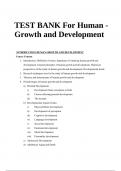Exam (elaborations)
TEST BANK For Human - Growth and Development
- Course
- Institution
TEST BANK For Human - Growth and Development.INTRODUCTION HUMAN GROWTH AND DEVELOPMENT Course Content 1. Introduction: Definition of terms, Importance of studying human growth and development, General principles of human growth and development, Historical perspectives of the study of human gro...
[Show more]



